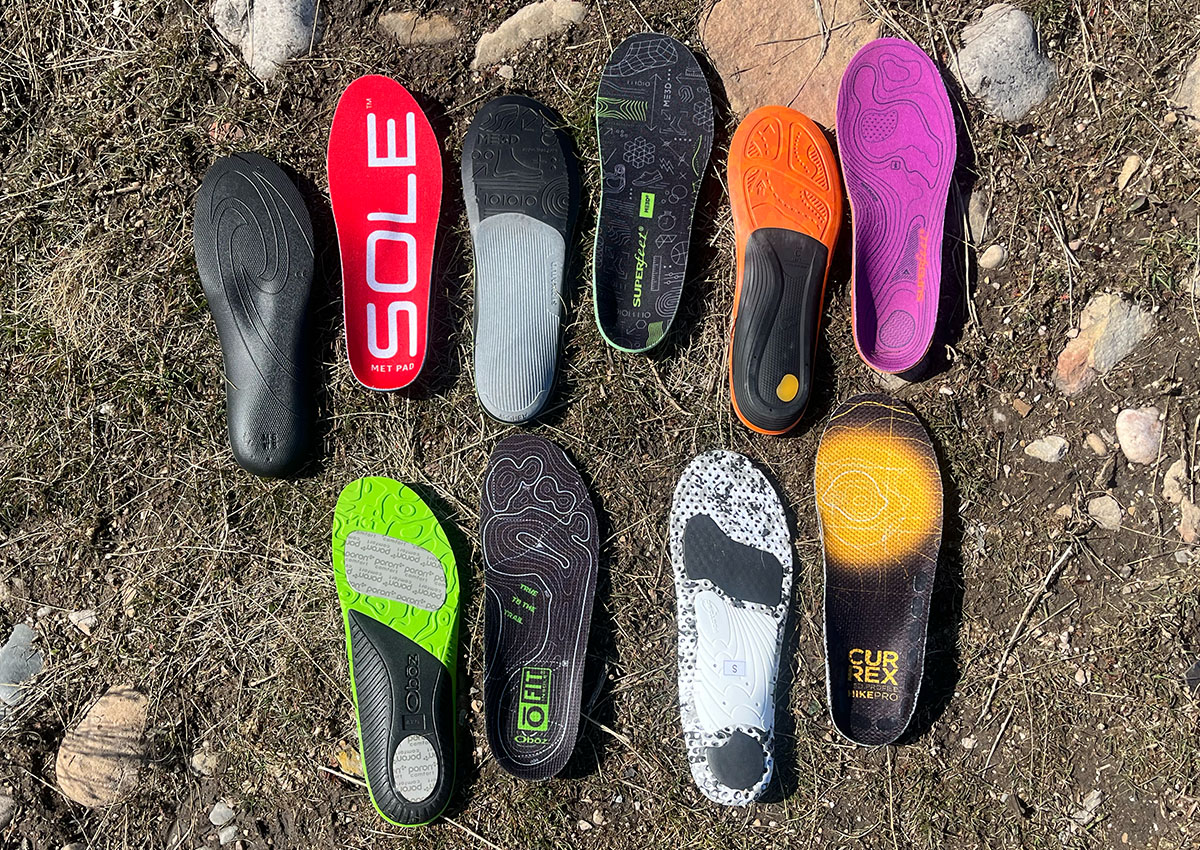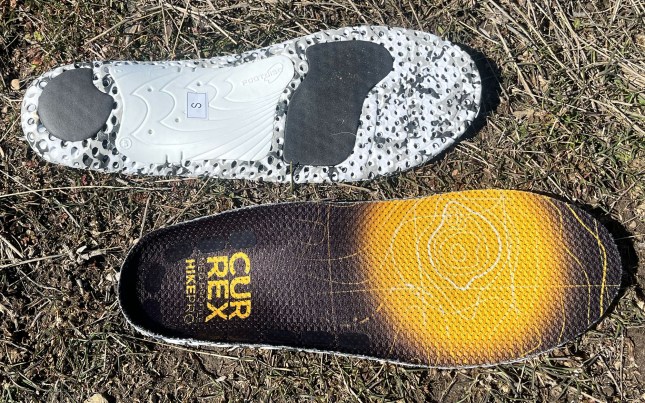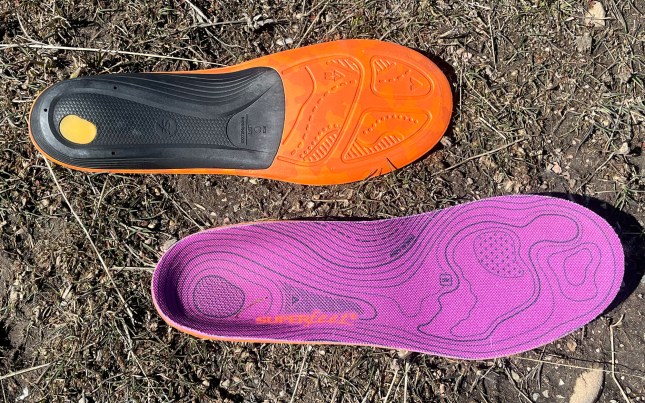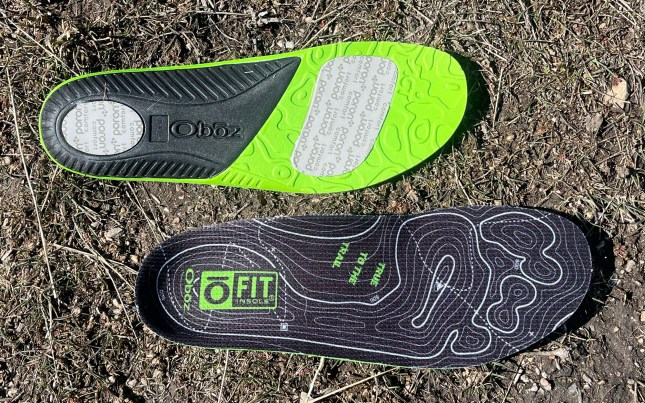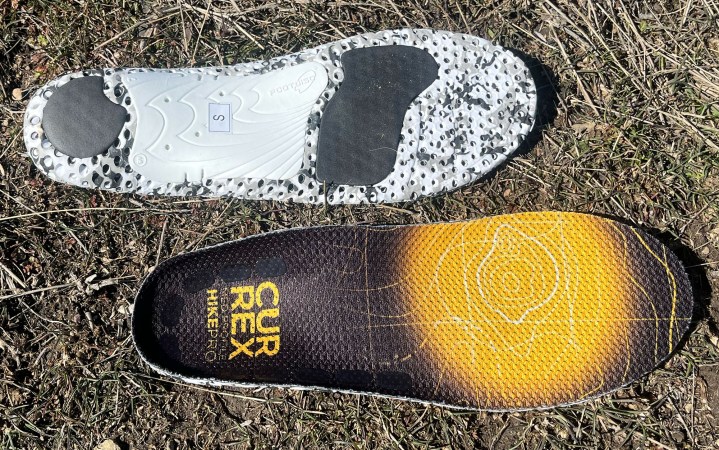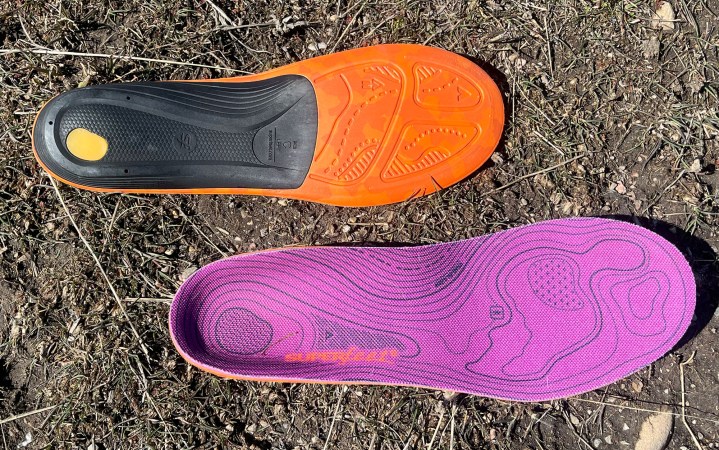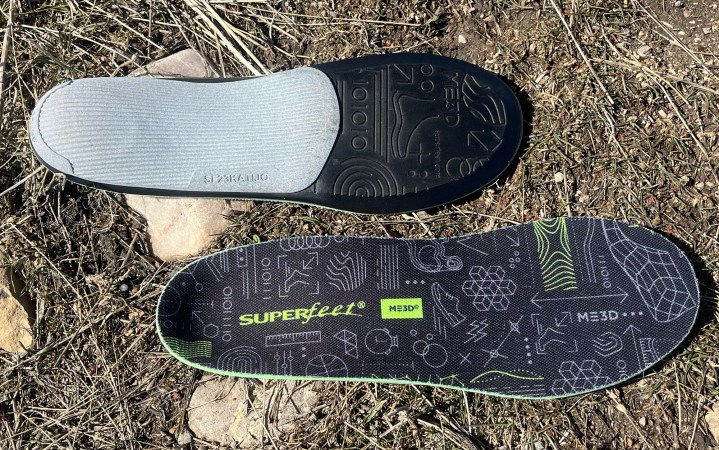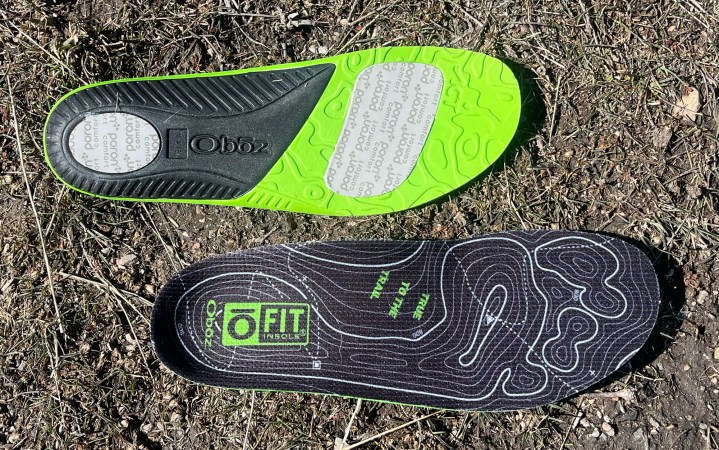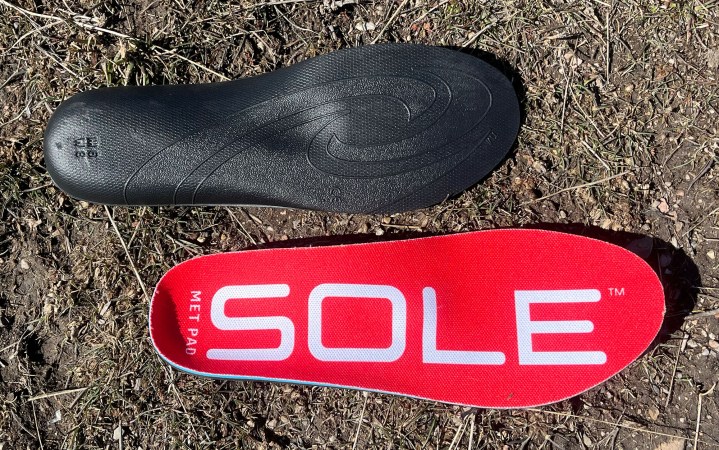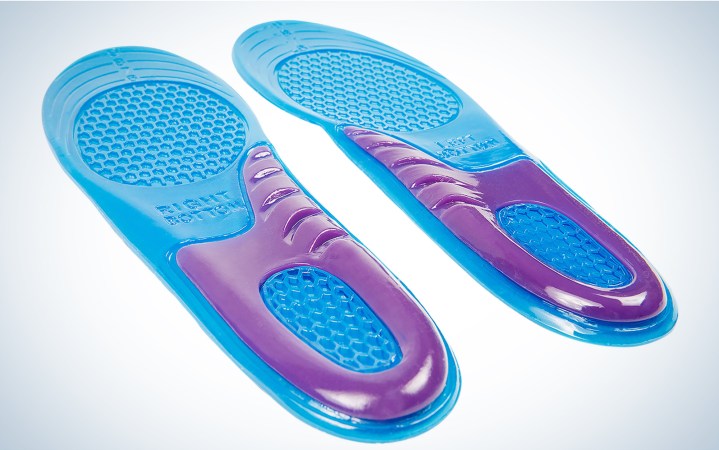We may earn revenue from the products available on this page and participate in affiliate programs. Learn More ›
If your feet hurt while hiking, you might benefit from insoles for hiking boots. First, take stock of your footwear. The right shoes are the first step, but if you already own a quality pair of hiking shoes, one of the best hiking insoles can alleviate pain. The insoles that come in your shoes are typically just a flat piece of foam. If the arch of your foot isn’t supported, it can cause problems like blisters, hot spots, supination or overpronation (your foot rolling out or in), and plantar fasciitis (a condition where the tissues in your foot become strained).
Blisters and hot spots can arise from excess friction in your shoe, and a thicker, more supportive insole can fill this space. Insoles can also give your foot a firm cradle to help aid in shock absorption and weight distribution to relieve stress on your body. I tested multiple models from the top brands to determine which are the best insoles for hiking.
- Best Lightweight: Currex HikePro
- Best Cushion: Superfeet Hike Support
- Best Custom: Superfeet ME3D
- Best for Flat Feet: Oboz Plus II
- Best Replacement: Sole Active
- Dishonorable Mention: Drugstore Gel Inserts
Things to Consider Before Buying the Best Insoles for Hiking
There are two parts of an insole: the arch support and footbed. The arch support is a hard piece, typically plastic or carbon fiber, that cradles the foot. The footbed is the fabric covered foam in the shape of your foot. Some may contain additional padding at the heel or forefoot, but the arch and footbed are the two main components. Let’s dive into how these can affect your hiking performance.
Arch Support
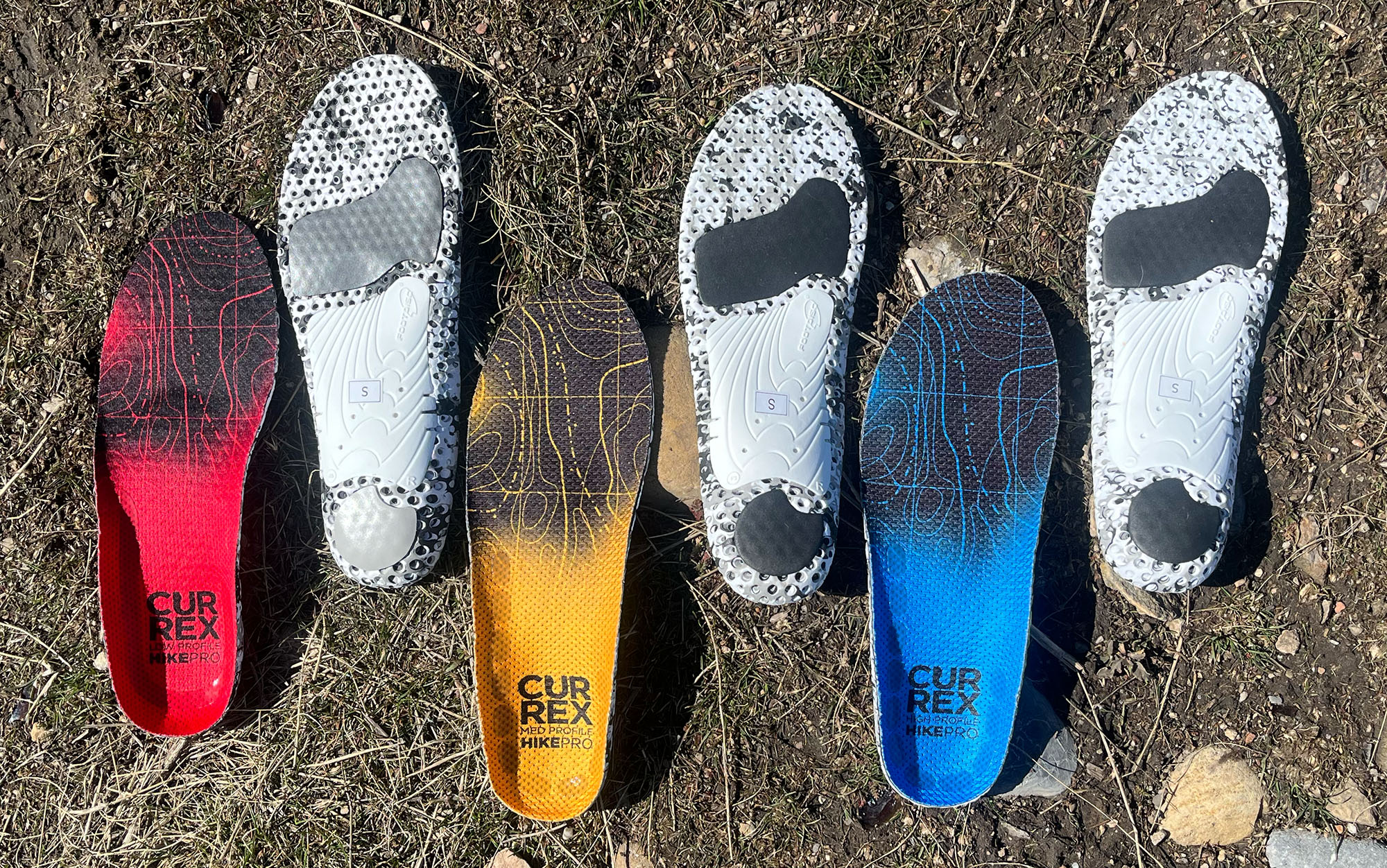
While everyone’s feet are different, most insoles are categorized by low, medium, or high arches. Selecting the right arch height is crucial. I spoke with Dr. Selina Sekulic from Salt Lake City’s Final Kick Ankle and Foot Clinic and she says, “If you are buying the insole to correct your rearfoot alignment, then you don’t want to choose an arch height that just positions your foot in its naturally poor alignment,” she explains. Sekulic frequently sees patients that have chosen too low of an arch profile. “If the over the counter options are causing blisters, or are just not tolerable, it’s time to invest in a customized orthotic,” Sekulic says.
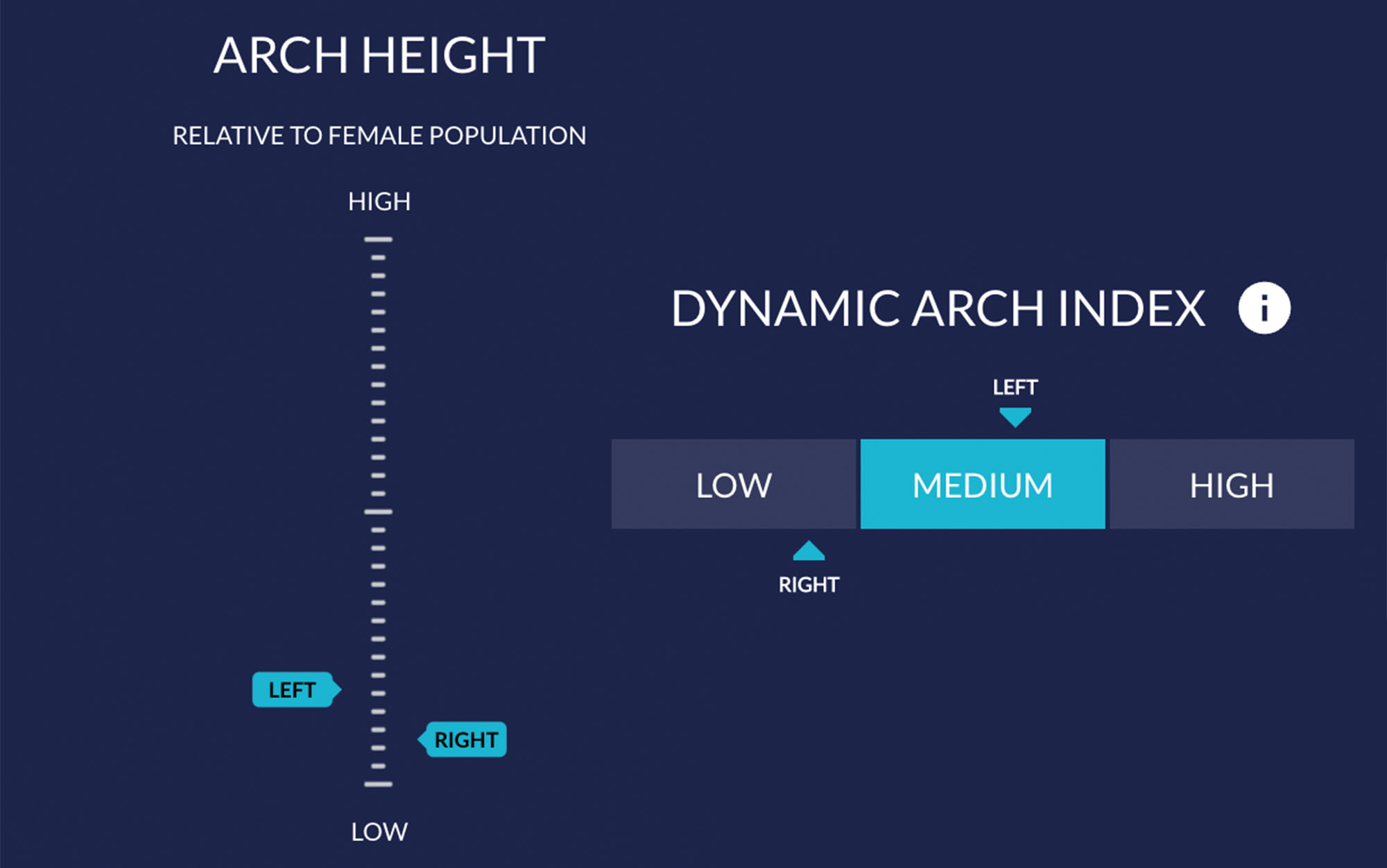
To find your arch height at home, you can wet your foot and place it on a paper towel, piece of cardboard, etc. to see the impression your foot leaves. Then compare your arch imprint to the different arch heights to determine your height. Another option is to try a Superfeet ME3D custom scanner. I visited Ossine Shoes in West Jordan, UT, to experience it for myself. While I don’t have foot pain while hiking, it was still an enlightening experience to receive so much data about my feet. For instance, I have low arches, but during the walking portion of the scan, my arch height slightly increased while in motion. This shows how important dynamic data can be.
Firmness
Currex’s CEO Lutz Klein told me that while the shape of their HikePro insoles are the same, the stiffness of the shank that supports your arch varies according to size and arch profile. The lowest arch profile is the most rigid, becoming more flexible with higher arches. This is because Currex isn’t aiming to change your foot profile, they’re filling the gap in your shoes. The more surface area of your foot in contact with the shoe, the less pressure and fatigue there will be from unnecessary movement.
If the bottom of your foot has constant contact, then the impact will be more equally distributed. The equation they use to achieve this on a mass scale is force / area = body weight x acceleration. (This is following the assumption that body weight is correlated to shoe size which according to Currex researchers is 89 percent accurate.) Your arch height changes in motion, as evidenced by my dynamic Superfeet scan. Therefore the best insoles for hiking must also be flexible enough to stay with your foot throughout the walk cycle.
Orientation
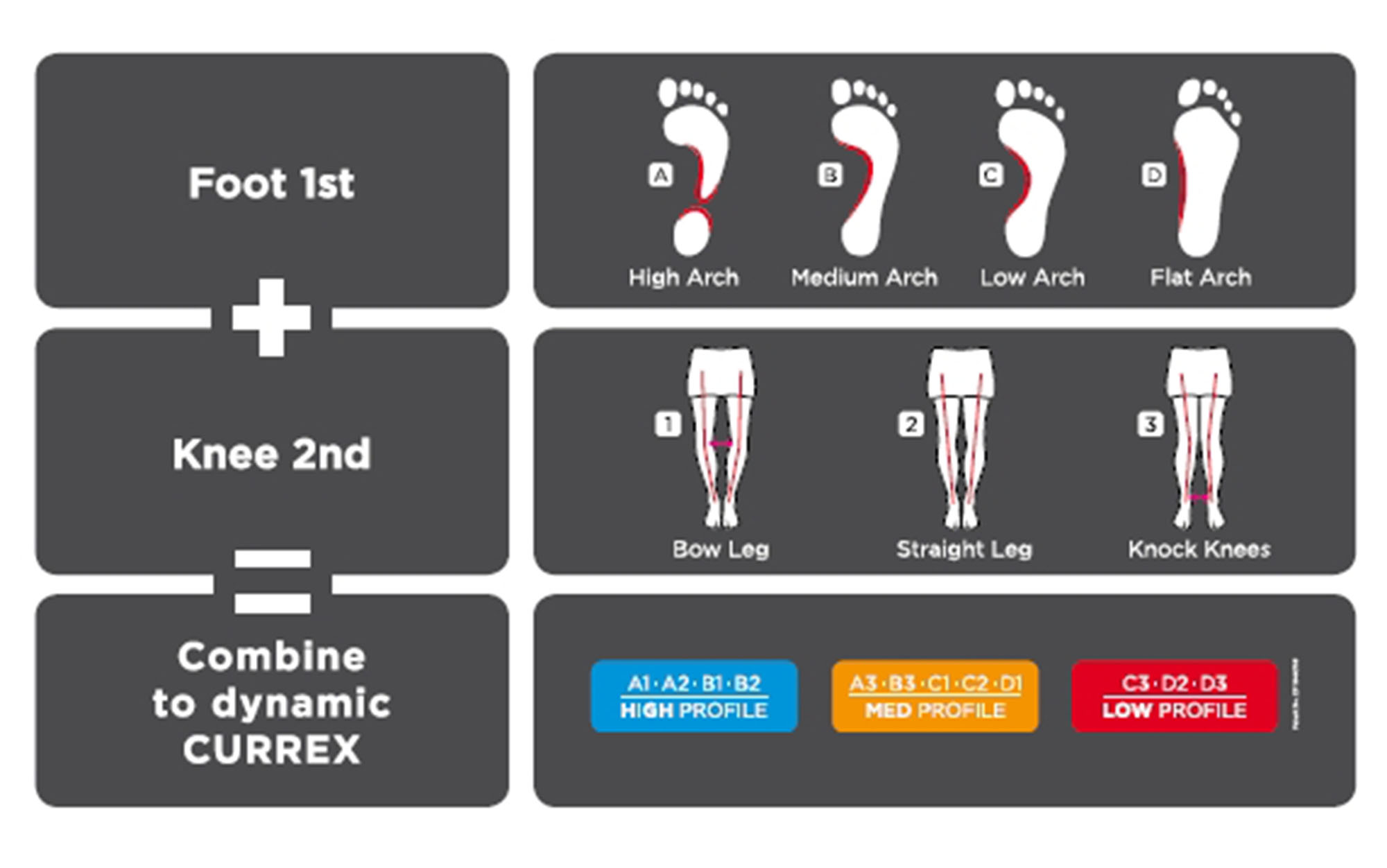
The orientation of your feet also plays a part in Currex’s arch profile. You can see in their at-home sizing method how your insole is dependent on your leg axis as well as arch height. This also helps visualize how an insole can alleviate problems beyond foot pain, like hip and knee issues.
However, the wrong insole can cause problems. Klein told me that Currex’s insoles will not cause long term issues if you pick the wrong arch height, because they are so flexible as to not alter your foot profile. But, Dr. Sekulic does caution against arch support that is too rigid. “Some people tend to roll to the outside of their foot (i.e supinate),” she explains. “An arch support which is designed to prevent the foot from rolling inwards (i.e excessive pronation) could potentially push the supinated foot into a more compromised position.” Essentially, be wary of discomfort in your insoles. If it is too rigid, you might not be absorbing shock properly which can lead to issues.
Comfort
Choosing an insole might seem daunting, but just like any other piece of gear such as backpacks or hiking shoes, you have to listen to your body. The insole you choose should make you more comfortable, not less. Dr. Sekulic warns that since the arch support in insoles is made of a hard substance like plastic or carbon fiber, they cannot be broken in like a shoe. “Insoles should feel comfortable after a few times of wearing them. If not, return them for a better fit,” says Sekulic. This is why the best insoles have a return period even after wearing or trimming to size to ensure a proper fit. Cushion in the insole’s footbed is also an important factor.
Your shoe volume can be affected by a too-thick or too-thin insole. Hiking boots typically have a large volume to accommodate thick socks and swelling. This gives plenty of room to replace the insole that came with your hiking boot with something more plush. The amount and distribution of cushion can also affect the performance of your shoes. Look for a zero drop to maintain the integrity of your footwear. The best insoles for hiking boots should work hand in hand (foot in foot?) with your shoe.
Best Insoles for Hiking: Review & Recommendations
Best Lightweight: Currex HikePro
Best Lightweight
Currex HikePro
Key Features
- Durability: 500-900 miles
- Silicone heel grips
- Deep decoupled heel cup
- Bamboo mid layer
- Poron heel cushion
- Propo+ forefoot
- Dynamic arch
- 60-day guarantee
- Weight: 2 ounces (measured)
Pros
- Lightweight
- Silicone heel grips
- Breathable
- Zero drop
Cons
- Less cushion
The Currex insoles are developed with motion at the forefront of design. The arch support moves with you, guiding your gait in a healthy way without attempting to change your foot shape. Although the arch is rigid, when in motion it flexes with your foot. I found the low profile HikePros to be the most comfortable while hiking, in terms of arch support. The Poron and Propo+ on the heel and forefoot is enough to aid in shock absorption while maintaining the integrity of your shoe. They don’t contain as much cushion as other insoles, but this is also by design to achieve a zero drop profile.
Plenty of insoles operate similarly to your boot in that they elevate your heel slightly above your toes. While drop is personal preference when it comes to shoes, your insole starts to compound this height difference. Currex’s zero drop along with the 2-ounces of weight won’t affect the performance of the best hiking boots you so deliberately picked out. But they absorb shock and reduce fatigue to make all the difference on high mileage days.
Currex’s HikePros are also the most lightweight and breathable insoles on this list. The bamboo mid layer and ventilated sole allow sweat or water to pass through and keep your feet dry. I particularly appreciated the silicone heel grabbers on steep descents.
Best Cushion: Superfeet Hike Support
Best Cushion
Superfeet Trailblazer
Key Features
- Durability: 12 months or 500 miles
- Aerospring Ascent Dual Comfort foam
- Heel Impact Technology pod
- EVOLyte carbon fiber stabilizer cap
- Deep heel cup
- Moisturewick
- 60-day satisfaction guarantee
- Weight: 3 ounces (measured)
Pros
- Comfort foam
- Stabilizer cap
Cons
- Only available in one medium to high arch profile
The Hike Support is available in a men’s or women’s version and it is specifically designed for hiking. The Aerospring Ascent Dual Comfort foam features two distinct layers of foam that are visible on the edge of the insole. I thought the foam was forgiving and the perfect thickness for my shoe volume while hiking. The cushioning reduces fatigue on long days but still feels stable in uneven terrain. It’s also treated with Moisturewick technology so your feet aren’t swimming in sweat. In addition to the plush but stable foam, a Heel Impact Technology pod disperses pressure on steep descents.
The carbon fiber stabilizer and deep heel cup mean you won’t slide around either. While there are no alternate arch profile options, the medium to high arch support is meant to stabilize the wearer on rough terrain, reducing stress on the feet, ankles, knees, and back. It didn’t bother my low arches and I felt like the insole was accommodating my foot, so I wasn’t making sacrifices for fit. The heel cup on the women’s model is supposedly more narrow, but I could’ve used more cupping or perhaps an adhesive to keep my heel locked back. Though if you agree, you can fix this with a heel locking lacing technique on your boots.
Best Custom: Superfeet ME3D
Best Custom
Superfeet ME3D
Key Features
- Poron Vive foam
- Personalized directional flex lines
- Customized variable stiffness zones
- Personalized arch profile
- Moisturewick
- 60-day satisfaction guarantee
- Weight: 5.4 ounces (measured)
Pros
- Custom comfort
- Specifically placed support
Cons
- Not great for steep ascents
- Heavy
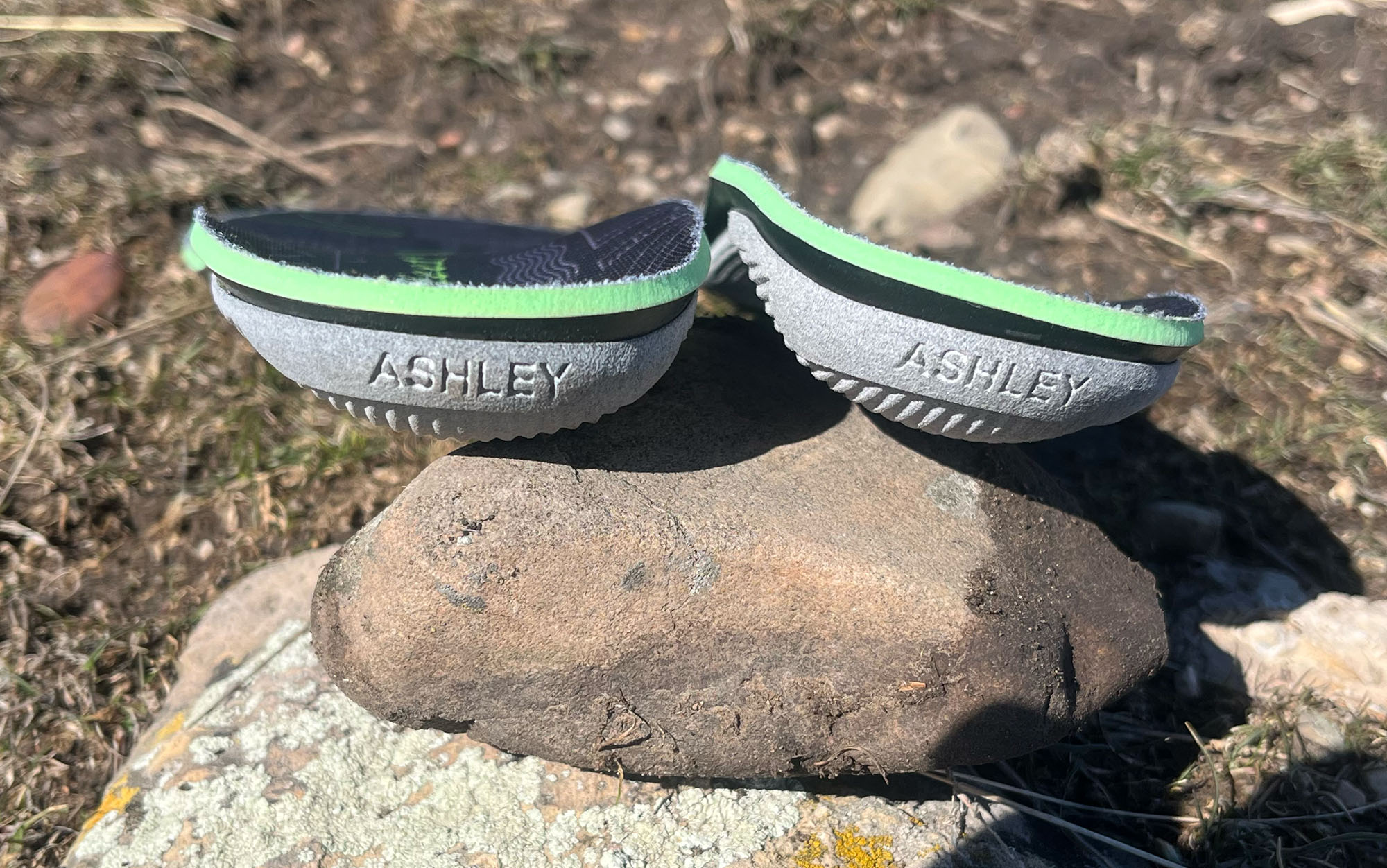
I think the reason the personalized arch profile in my custom Superfeet ME3Ds is so comfortable is because it not only 3D prints the exact height of your arch, but also the position. The arch supporting shanks are the most rigid on this list, but they’re also extremely comfortable, meaning that the stiffer support is more beneficial to my foot in exactly the right spots. This makes sense considering low arches need more rigidness.
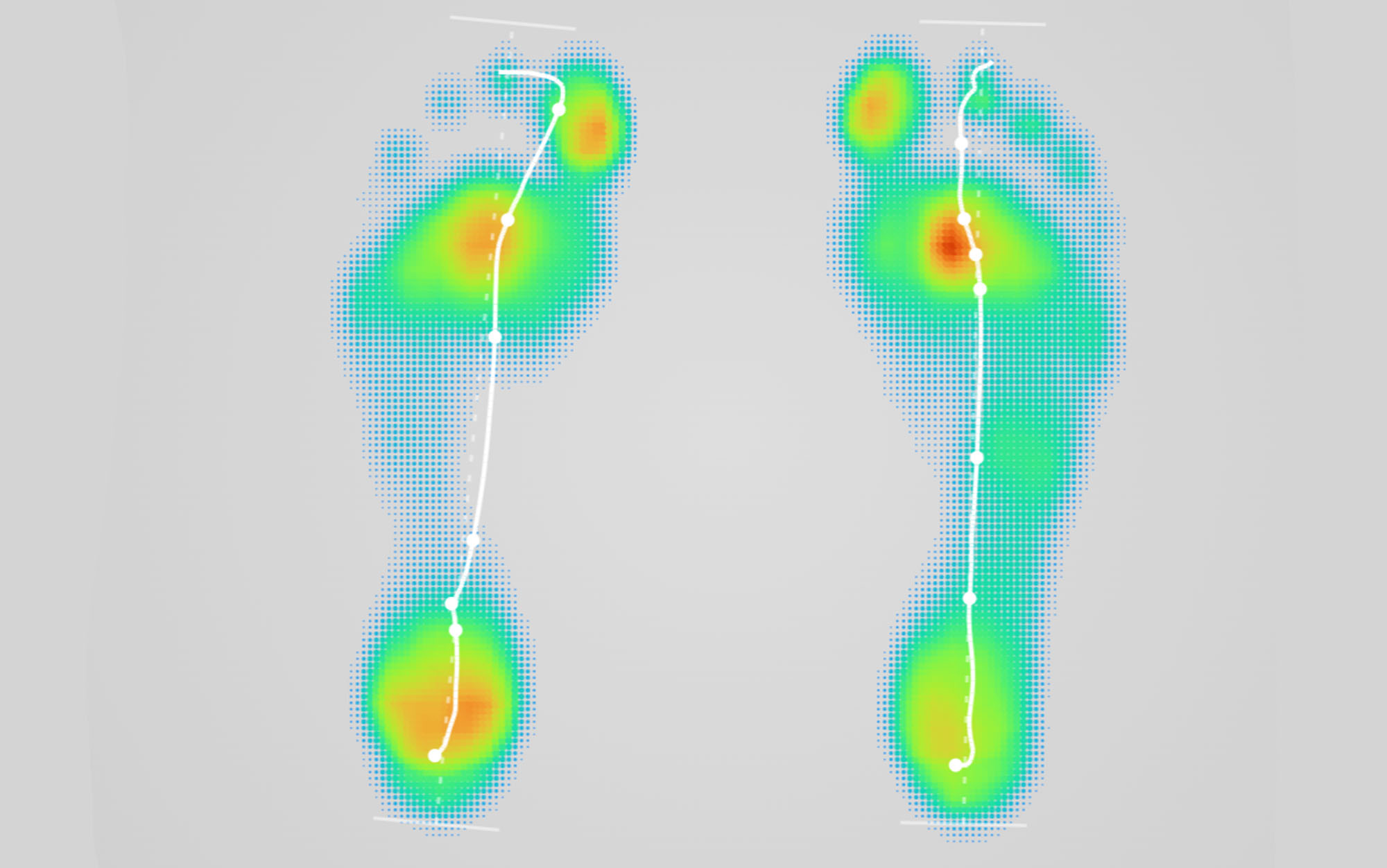
There are five different zones on the custom 3D-printed, carbon fiber arch support. They each contain variable flexibility determined by the dynamic portion of my foot scan. I walked across a pressure pad three times to determine where I place the most pressure in motion. The heel of the arch support shank features a personalized angle of lines designed to guide my foot during the walk cycle. While hiking I thought these felt heavy, but overall supportive. However, on a steep incline I realized the stiff heel cup was catching my foot and not allowing me to extend fully during the climb.
Best for Flat Feet: Oboz Plus II
Best for Flat Feet
Oboz Plus II
Key Features
- Dual-density EVA
- Deep cushioning heel cup
- Poron Comfort pods under the metatarsal and heel
- Cleansport NXT
- Weight: 3 ounces (measured)
Pros
- Flexible
- Cushioned
- Lightweight
Cons
- Only medium arch profile
- Minimal arch support
- No satisfaction guarantee
My low arches were perfectly happy in the medium profile Oboz, the only profile they offer. The flexibility of the high-density EVA foam means even those with flatter feet won’t be bothered. The shank isn’t rigid and feels forgiving. It is designed to put your foot in a neutral position, so it provides some support without being overly pushy. They’re comfortably cushioned with additional Poron pods at the heel and forefoot. These aid in shock absorption and energy return.
This Oboz insole comes in all of their footwear as well, so if you own Oboz shoes you can replace a worn insole so it feels like the day you bought them. If your hiking boot insole isn’t comfortable enough, this plush, odor-resistant, flexible replacement could fix your issue. Unfortunately, the Oboz 1-year warranty only covers manufacturer defects and they won’t take it back if you wear it for a few hikes and don’t like it.
Best Replacement: Sole Active
Best Replacement
Sole Active
Key Features
- Heat and wear moldable for customized fit
- Polygiene stay-fresh technology
- Zero drop
- Deep heel cup
- Available with metatarsal support pad
- Available in wide
- EVA foam
- Weight: 3.3 ounces (measured)
- 90 day guarantee
Pros
- Zero drop
- EVA foam
- 90 day guarantee
Cons
- One size arch profile
- Minimal cushion
Sole is best known for their cork based insoles. However the best insoles for hiking should be durable and breathable, so for their active line Sole switched to EVA foam. I tested the Active Medium which felt good at the heel but slightly roomy at the toes. However, the width of the footbed provided good toe splay. If your boots have a larger foot volume, there is a thick version.
I appreciated the light weight and zero drop of these insoles; I would happily throw a pair in my bag on a soggy day or long trip to substitute my wet and smelly insoles with a fresh pair. The base is solid meaning it isn’t very breathable, but the Polygiene stay-fresh technology should keep them from smelling. The one-size fits all arch profile might not work for everyone. There is minimal support and cushioning. Technically they should heat mold to your feet, but I didn’t notice any difference after putting them in the oven and standing on them for 2 minutes. I would treat these as a good replacement for your current insoles if they’re worn down or wet, but not a solution to foot pain.
Dishonorable Mention: Drugstore Gel Inserts
Dishonorable Mention
Drugstore Gel Inserts
Key Features
- Silicone gel
- Honeycomb design
- Weight: 4.5 ounces (measured)
Pros
- Cheap
Cons
- Entirely unhelpful
I decided to test a pair of drugstore gel inserts to see how they compared to the best insoles for hiking boots, and let me tell you, my already low expectations were not met. These were far worse than the admittedly already very comfortable insoles in my Salomon X Ultra Pioneer Mid Climasalomon Waterproof boots.
The foam insoles provide stability, shock absorption, and breathability in a lightweight package. The gel insoles are flat with no arch support and you can feel everything under your feet. My feet slid around inside my boots and there was even less cushion than before. If your feet are aching, skip this $15 detour and invest in some quality hiking insoles.
How I Chose the Best Insoles for Hiking Boots
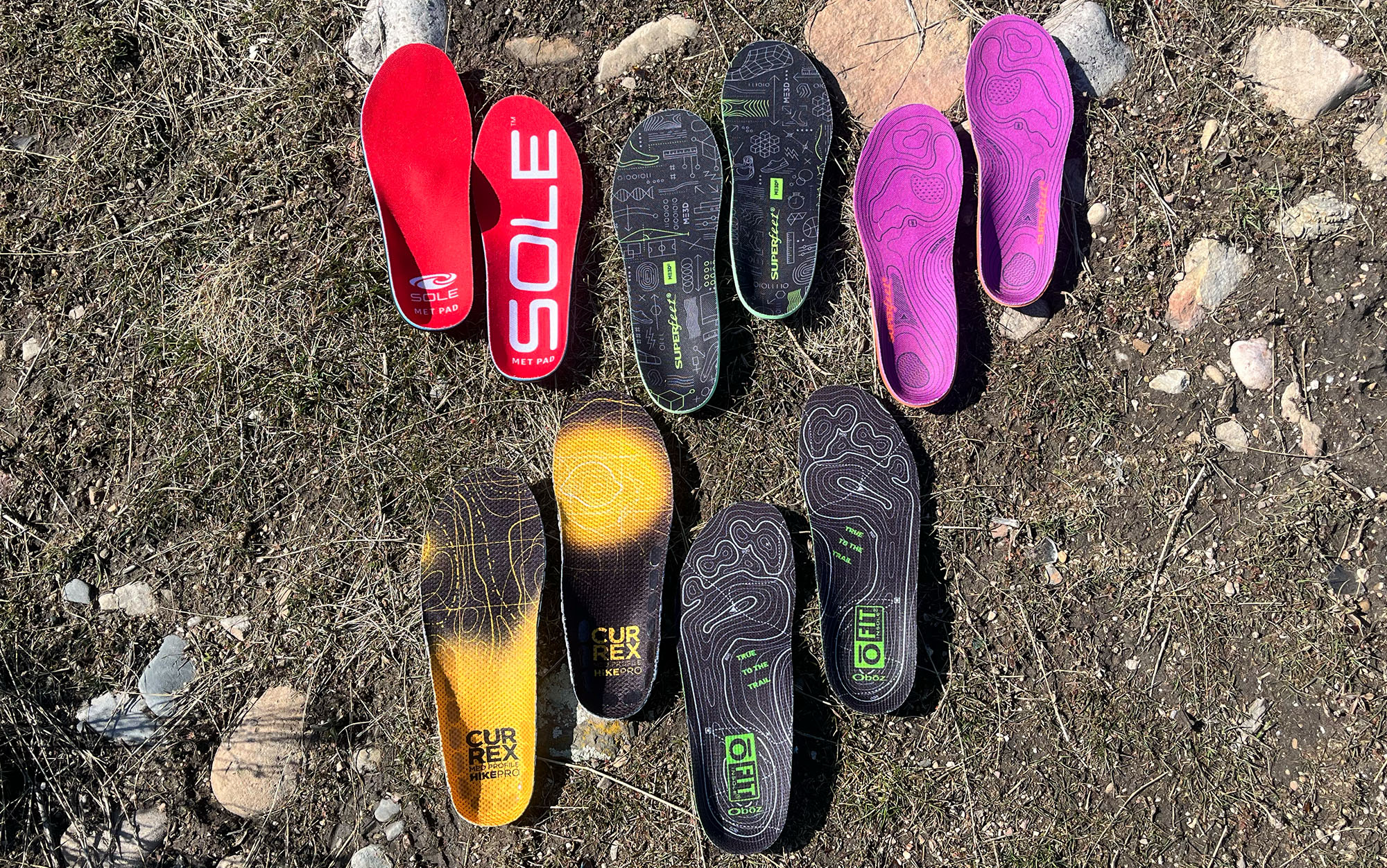
You spend a lot of time and money picking out the perfect shoes tailored to your preferred activities and foot shape. So why do you now have to buy another product? Shouldn’t the performance footwear we obsess over be enough? For some people, it is. But as you tackle more intense objectives and get older, you could start to notice that factory footbeds just aren’t cutting it anymore.
Most of the insoles on this list are personalized in some way whether it’s Currex’s sizing formula to determine which of 26 different arch supports are right for your size and arch height, or Sole’s heat molding, or Superfeet’s custom 3D printed shanks. If you factored this into buying shoes, things would get a lot more complicated and expensive. So, it’s left to after-market insoles to help those that are looking for more support and performance.
I tested the top brands making hiking-specific insoles and spoke with a reconstructive rearfoot and forefoot surgeon, the CEO of Currex, and had my feet 3D scanned by Superfeet to understand how the best insoles for hiking can take you farther.
When to Consult a Doctor
While the insoles on this list are great for a more comfortable hike, relieving some pain, or preventing a more serious injury, you should see a doctor if you’re in a considerable amount of pain. Dr. Sekulic says “There are various soft tissue and osseous problems that can cause foot pain. A custom orthotic can be modified to address those specific problems and bring you significant pain relief.” While this route is more expensive, Sekulic says proper foot care “ultimately leads to more steps each day.” Which is what we are all after, right?
FAQs
If you’re developing blisters or hot spots, you could prevent them by decreasing the excess space in your shoes. A supportive insole might relieve pressure points in your boots. If you’re experiencing foot, hip, or knee pain, it could be a result of supination or overpronation (your foot rolling out or in) or plantar fasciitis (a condition where the tissues in your foot become strained). Quality insoles can solve these issues. If you’re in consistent or considerable pain, consult a doctor.
Plenty of people have none of these issues and simply prefer more cushion and support in their performance footwear. Insoles can also prevent injuries by guiding your gait in a healthy way. If you have a long trip, plan to cross rivers, or get caught in a downpour, a pair of fresh insoles can make your boots more comfortable and drier as well.
The life of your insoles varies wildly depending on your activity level, terrain, frequency, and weight. However, the best insoles should last you around 500 miles. If your feet start to tire or you notice your insoles are excessively worn, go ahead and replace them. A good rule of thumb for moderately active hikers is to buy new insoles every year.
You should handwash your insoles with warm water and soap. Then air dry them completely before putting them back in your shoes. Putting them in the dishwasher or washing machine could cause them to deform and get ruined.
Why Trust Outdoor Life?
Since 1898, OL has been a leading authority in testing and reviewing hunting gear, fishing tackle, guns and shooting equipment, and much more. We have more than a century-long history of evaluating products, and we’re now bringing that expertise to online reviews. Our editors are experienced outdoorsmen and women, and most importantly, we’re trained journalists. We prioritize field testing and objective data when reviewing products. We conduct interviews with gear manufacturers and engineers as well as outdoor experts so that our readers have an understanding of how and why a product works—or doesn’t.
Advertising does not influence our gear reviews and it never will. While we always focus our coverage on standout products—because we want our readers to be aware of the latest and greatest gear—we also cover the flaws and quirks of any given product.
Final Thoughts on the Best Insoles for Hiking
You can avoid aching feet for good with the best insoles for hiking. If you’re looking to refresh your shoes mid-hike, the Sole Active line can help keep your feet feeling comfortable and dry. For intense hikers looking for increased performance, I would recommend the Currex HikePros. If all you need to keep moving is some extra cushion, go with the Superfeet Hike Supports.
- Best Lightweight: Currex HikePro
- Best Cushion: Superfeet Hike Support
- Best Custom: Superfeet ME3D
- Best for Flat Feet: Oboz Plus II
- Best Replacement: Sole Active
- Dishonorable Mention: Drugstore Gel Inserts
